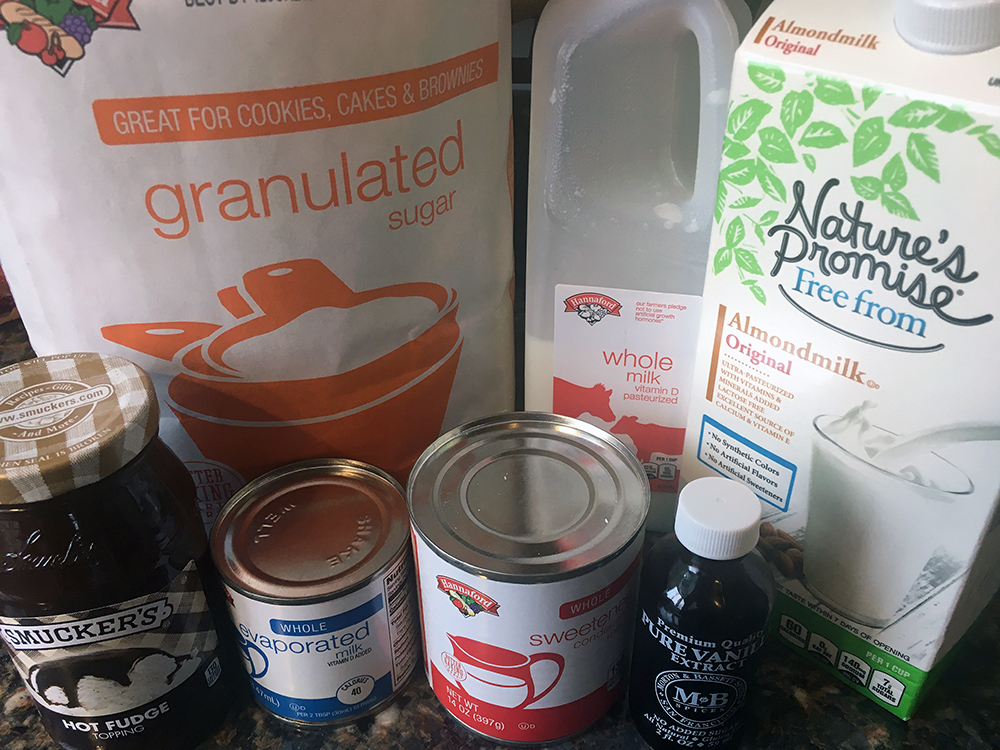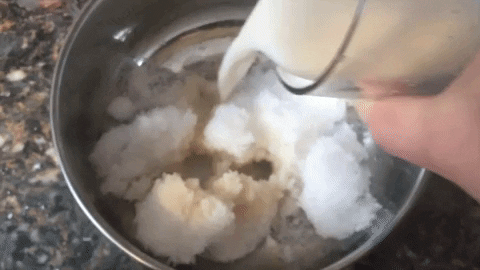I tried some recipes for snow ice cream. Here’s how it went.
In the suburbs of Washington, D.C., where I grew up, the entire metropolitan area will shut down for a light dusting of snow. Still, my family had no snow day traditions to speak of. My city-born parents were skeptical of the stuff, and aside from the occasional bout of tubing down the slope of our front yard, we tended to retreat indoors for reading and cocoa. After I moved to Maine, I wanted to take advantage of the snowy winters and make some traditions for myself. When I stumbled upon the numerous recipes for snow ice cream, I knew I had hit the jackpot.

Snow ice cream is the combination of freshly fallen snow with cream, sugar and a flavoring agent. Combined, the ingredients melt and congeal into a chilly, creamy dessert. Snow ice cream is not to be confused with “snow cream,” also known as “milk snow,” which is European recipe dating back to the late 15th century that combines cream, rosewater and sugar, whipped until stiff.
The origins of snow ice cream are difficult to verify, but the technique is practically ancient. Archaeologists discovered what is thought to be the first “ice cream” cup — a bifurcated silver chalice, filled half with cooked and fruit and half with snow — in an Egyptian tomb dating back to around 2700 BC. Pre-Columbian Ecuadorians brought blocks of ice and snow down from the top of the volcano Imbabura to mix with fruit juice (and, sometimes, milk) in a cauldron until it all froze together. “Helados de paila” are still prepared this way today in some parts of Ecuador.
Snow ice cream can be made anywhere it snows, but it has a surprisingly passionate fanbase in the American South. Kentucky-born country singer Loretta Lynn recalls her mother’s recipe for snow ice cream in her book “You’re Cookin’ It Country:” freshly-fallen snow collected in a dishpan, three beaten eggs, vanilla and sugar.
Most modern, salmonella-adverse recipes have ditched the eggs in favor of some sort of cream, whether it be condensed milk, evaporated milk, whole milk or plant-based milk. Because I was so eager to master this snow-day treat, I decided I would attempt all four of these different recipes for snow ice cream. The wistful, wannabe-snow bunny still inside me would appreciate it.
Learning to try
When it comes to snow ice cream, the first question that comes up with parents and hypochondriacs alike is whether it is safe to eat snow. The short answer is yes, but there are some rules.
Keep a keen eye out for any contaminants (yellow snow is obviously a no-go). Never eat snow that has been plowed, as it will contain melting agents like salt or magnesium chloride. The best time to eat snow is a few hours in to the snowfall, when the air is slightly clearer of pollutants and the flakes are still fresh. Avoid eating snow that’s been sitting outside for long periods of time — aside from the accumulated contaminants, it may contain snow fleas. Very young children, elderly people and individuals with compromised immune systems may want to pass on snow treats altogether, just to be safe.
To keep my snow fresh, I set out a bowl in the morning to catch the snow separately. The snow storm had been raging since the night before, so I figured most of the pollutants that would taint my snow ice cream had dissipated by then.

Then, I set off to find recipes for snow ice cream using the many variations on “cream” I wanted to test. I found this recipe from the blog Happy Hooligans that used condensed milk, this recipe from the blog Bless This Mess (funny, there’s a show now with the same name) and this recipe from Allrecipes that uses milk.
For good measure, I also wanted to find a recipe for snow ice cream with a plant-based milk (for our lactose-intolerant and vegan readers, of course). I found this recipe for dairy-free homemade snow ice cream from the Humbled Homemaker that said you can use any variety of plant-based milks. I chose almond milk, though I didn’t have time to make my own batch this time around.
A trying experience
I waited for a few hours, until the snowfall filled my bowl. After I brought it indoors, time was of the essence. I set up and opened all my materials beforehand so I wouldn’t lose precious seconds to melting.
I tested condensed milk first. Because it was sweetened, it did not require any sugar, only a dash of vanilla. I was so eager to taste it (and — fair warning — snow ice cream is much colder than store bought varieties) that I immediately struck with a debilitating brain freeze.
The consistency was not as solid as ice cream, but it tasted like a delicious, slushy vanilla sorbet. The vanilla flavor shone through, even though I only used a drop or two of vanilla extract.
Next, I tried evaporated milk, which is slightly thinner and less creamy than its condensed counterpart. Both condensed milk and evaporated milk are forms of concentrated milk, in which approximately 60 percent of the water content has been removed. However, condensed milk is sweetened while evaporated milk is not, so the recipe recommended adding sugar.
Despite my best mixing efforts, the ingredients struggled to combine, and the sugar never fully dissolved. I found myself nearly chewing on this snow ice cream to get through the sugar granules and ice. Perhaps mixing the sugar and evaporated milk together separately would have been a better choice.
Then, I tried the recipe for snow ice cream with whole milk and sugar. The final product looked like grits and tasted like a sugary, watery gazpacho. I added more snow to improve the texture. It held together slightly better, but was still too mushy for my taste.

Finally, almond milk. In my rush to finish the experiment before the snow melted, I afflicted myself with another awful brain freeze. After the pain passed, though, I actually liked the flavor of the almond milk snow ice cream slightly better than the whole milk-based one (perhaps because I accidentally spilled a whopping dollop of vanilla extract into the mixture). The consistency was slightly less soupy, too, perhaps because almond milk is mostly water and it just froze right up alongside the snow.
Sampling all these recipes for snow ice cream left me with a slushy belly, a sweet sugar high and a clear favorite: condensed milk. Using the rest of the snow, I prepared a giant bowl of it with a drizzle of hot fudge to eat on the couch while watching my favorite snow day movies.
My tried-and-true takeaways
Between the built-in sweetness and the binding power, I think condensed milk is the clear winner. If you want to use one of the others, I would mix the sugar and vanilla in separately with the cream before adding it to the snow to ensure that the flavors combine.
My sample sizes were fun for the experiment, but the actual recipes require between six cups and a gallon of snow, so you do need to start with a lot and use your creams and sweeteners sparingly to prevent the whole thing from turning to mush. That, and you have to work quickly because it will melt much faster than regular ice cream — but not so fast that you give yourself a brain freeze.

Overall, the activity is a fun way to make blizzards a little more enjoyable. Plus, I think I found a snow day tradition to call my own.
